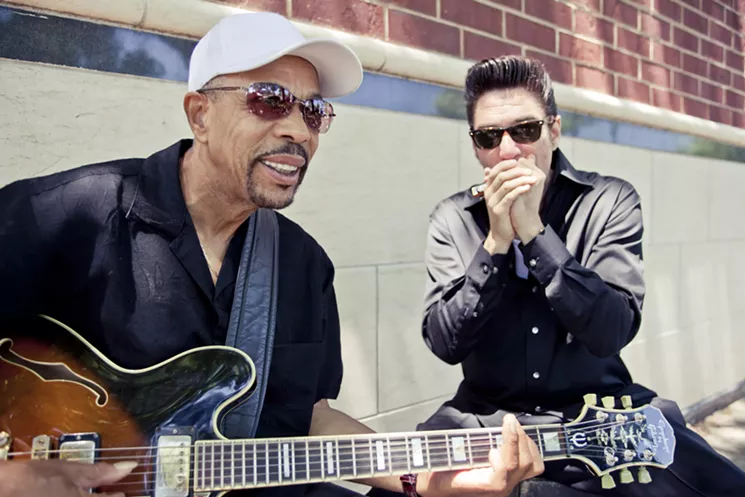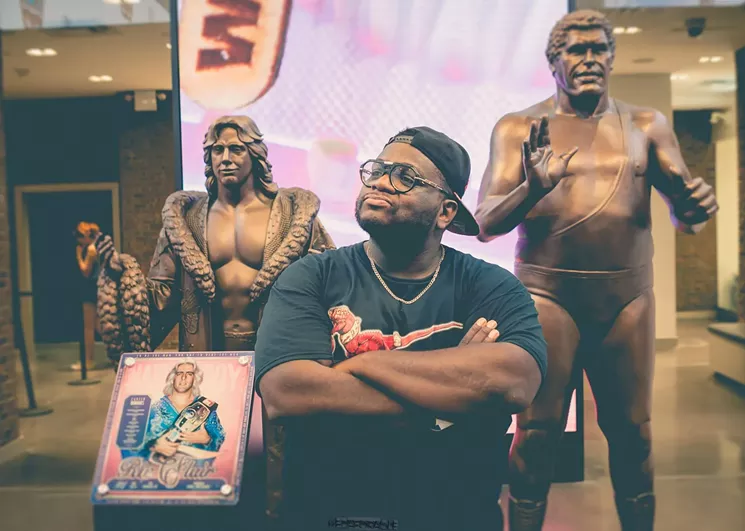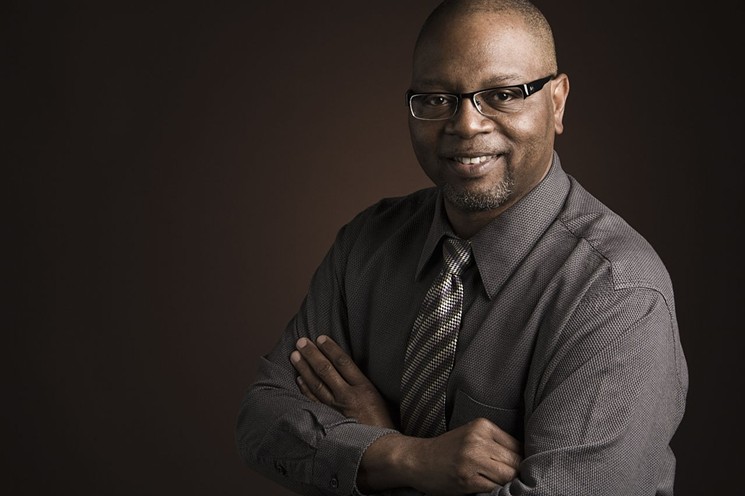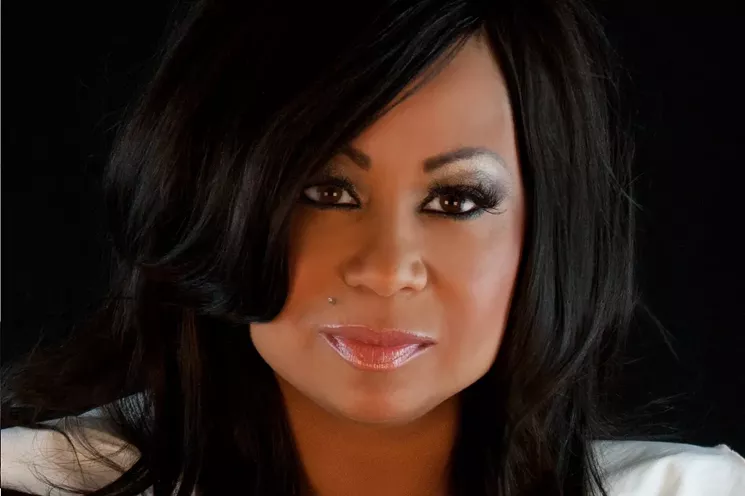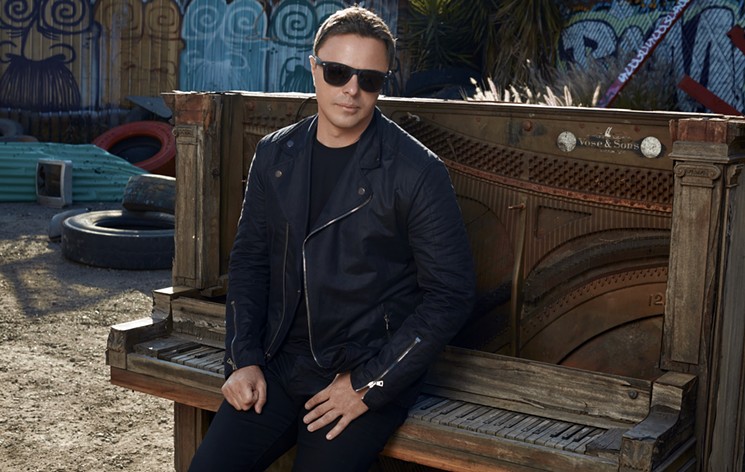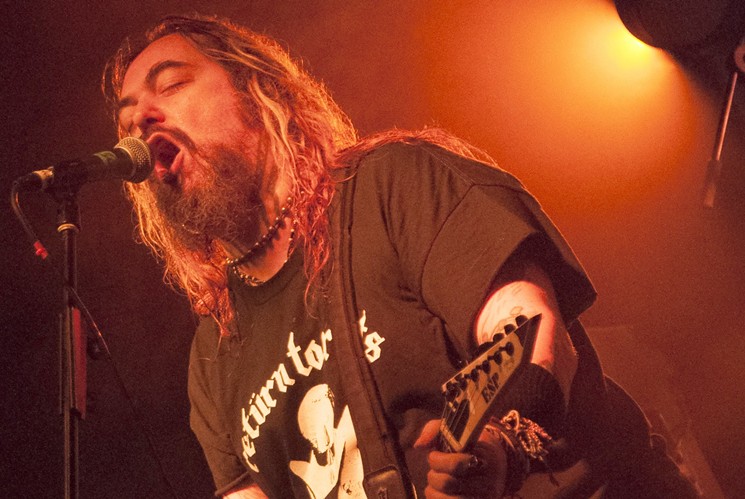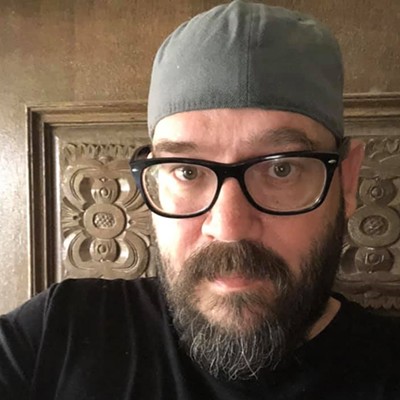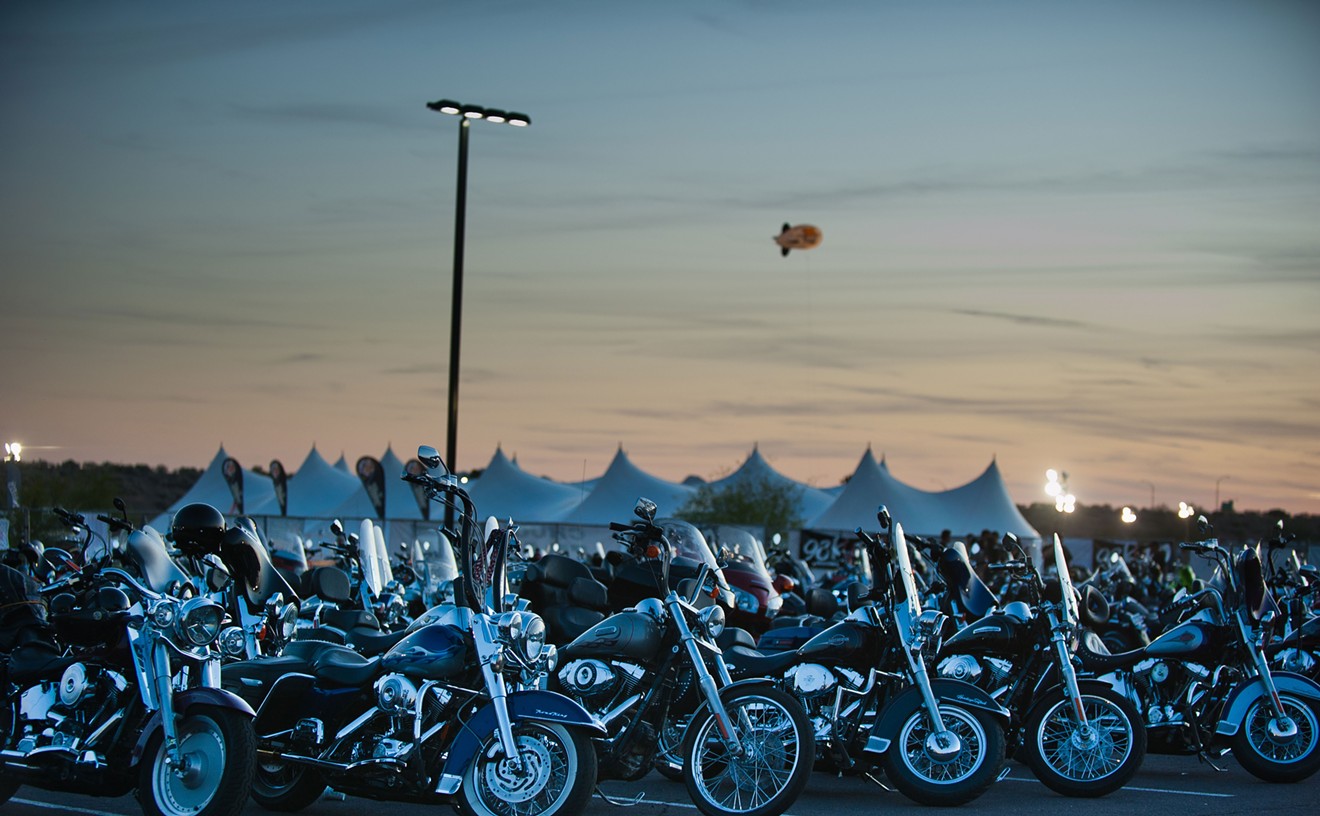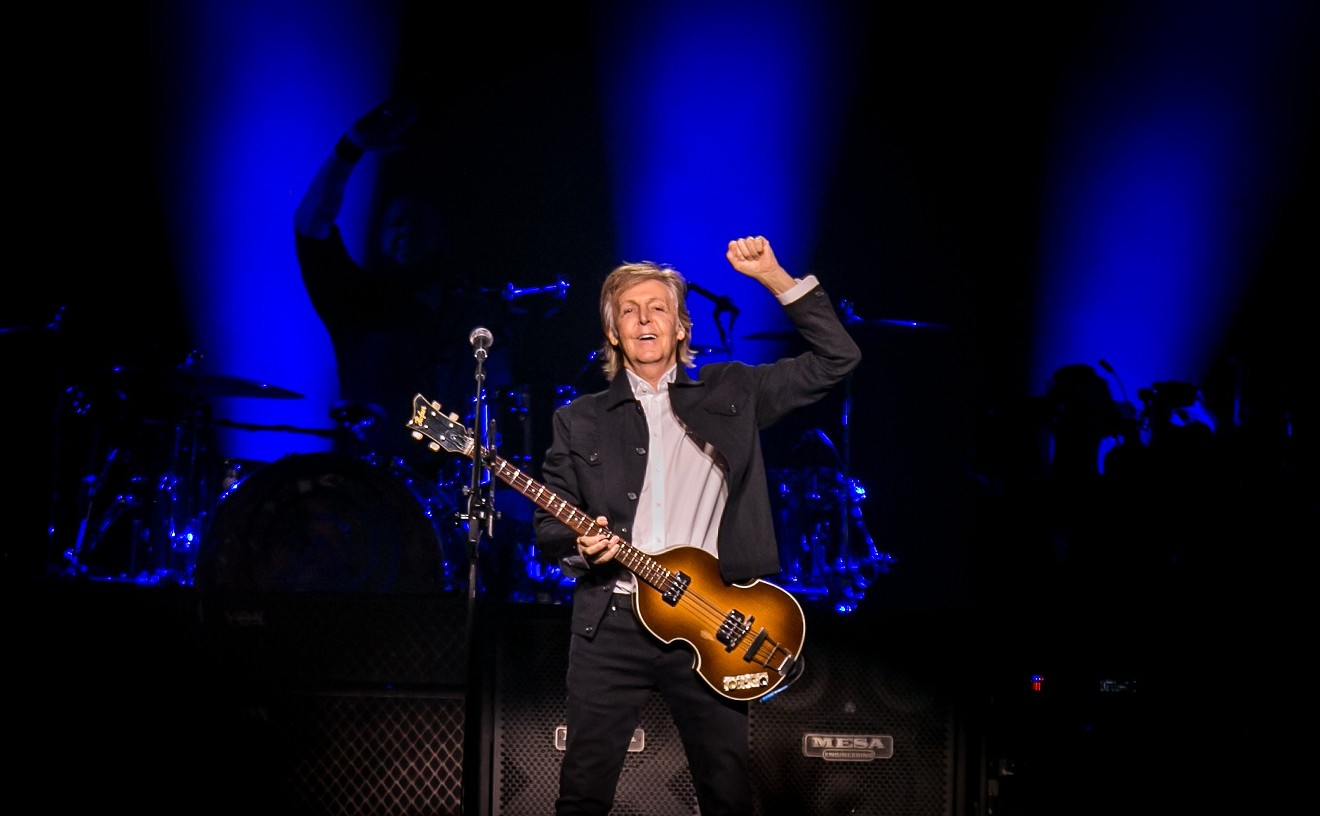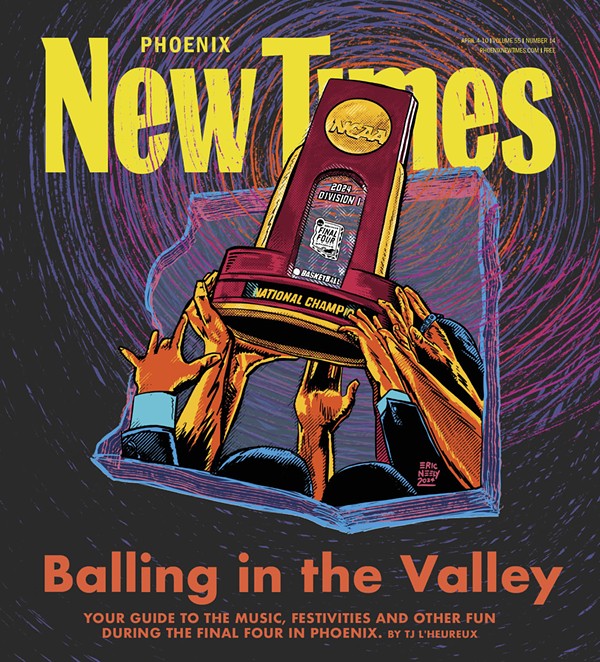Go further and there are illustrious artists like Duane Eddy, Sam Moore, and Jason Newsted, all with ties to Arizona and a substantial legacy in the music world.
Our state is rife with musicians and bands whose influence has been felt in the Valley and around the globe. Unlike the aforementioned legends, they may never be immortalized in the Rock and Roll Hall of Fame, but nonetheless deserve recognition.
That includes artists like art-rock weirdos Meat Puppets, punk agitator Frank Discussion, and the late songwriter and guitarist Doug Hopkins, each of who contributed to music history both locally and nationally. Ditto for such non-rockers as jazz percussionist Lewis Nash, mashup guru Z-Trip, and Mexican-American guitarist Lalo Guerrero.
You’ll find all of these names on our list of Arizona’s most influential musicians. Some have deep roots or spent a significant amount of time in our state, others started their careers here.
This list isn’t just based on our opinions, as we consulted people well-versed in Arizona’s musical past, including music historian John Dixon (a.k.a. DJ Johnny D), venerated record store owners Kimber Lanning and Michael Pawlicki, and veteran concert promoter Danny Zelisko.
We've assembled a wide-reaching collection stretching across genres and encompassing a diverse cast of characters. There are pioneers and innovators. There are visionaries and trendsetters. There are even a few oddballs and outlaws.
Z-Trip
Hold it. Before you start arguing about how this Arizona expat is a DJ, and thus, not a true musician, consider the following: The record decks that Z-Trip wields and works into performances are essentially musical instruments, and the scratches, chirps, and flares getting laid down are his notes. He's also got an encyclopedic arsenal of music at his disposal, and was widely recognized as a pioneer of the then-nascent music genre of mashups in the early aughts.Just like an ace songwriter or composer, he crafts mixes and sets with structure, pacing, and energy that ultimately lead listeners on an epic journey. And, really, any significant innovations in music over the last century have involved taking established styles, rearranging and reworking various elements, and creating something new, exactly like one of Z-Trip's mixes.
Bob Hoag
Dapper local drummer Bob Hoag has played a significant role in local music for going on three decades. As a musician, he's performed in a string of memorable acts — including Pollen, The Go Reflex, The Love Me Nots, and Samuel L Cool J — while also working as a sought-after engineer, producer, and sound guru who has mentored, advised, and recorded a vast array of Phoenix and Tucson bands at his Mesa studio Flying Blanket Recording.“Bob has been critically important, not only as a songwriter but behind the scenes as a recording engineer,” Stinkweeds Records owner Kimber Lanning told Phoenix New Times in 2014. “He's just a whiz in the studio, and helped shape a lot of things coming out of Arizona.”
Hans Olson
In the decades since Hans Olson moved to the Valley in the late 1960s, he’s served as a venue proprietor, session musician, songwriter, label owner, event promoter, and founder of the Arizona Music and Entertainment Hall of Fame. The renowned bluesman is also a living legend and one helluva performer who’s toted his harmonica and slide guitar around the world and played alongside the late Muddy Waters and B.B. King.In the ’70s, Olson opened for the likes of The Allman Brothers Band and Boz Skaggs, toured with Dave Mason, headlined at the Whiskey A Go-Go in L.A., and raised a lot of hell with onetime drinking buddy Tom Waits. In the mid-'80s, he also ran Tempe venue The Sun Club and helped such bands as Gin Blossoms and Dead Hot Workshop get their start. They aren’t the only notable locals that Olson has influenced over the years, as artists like The Sugar Thieves and other modern-day musicians have cited him as a mentor.
Bob Corritore
Bob Corritore arrived in Phoenix in 1981, figuring he'd be here for a year at most. Four decades after the fact, the harmonica player is still around, and local blues connoisseurs are grateful he decided to stay. Since the mid-'80s, he's served as Phoenix's reigning blues guru, broadcasting choice cuts and sharing an infectious fervor for the art form during his weekly Sunday night show on KJZZ 91.5 FM, Those Lowdown Blues. Meanwhile, Corritore has also devoted the past 18 years to making his Phoenix joint, The Rhythm Room, a go-to spot for blues and roots music.It's become hallowed ground, having featured gigs by such giants as Pinetop Perkins, Leon Redbone, and Jimmy Rogers. A number of renowned artists have also recorded live at The Rhythm Room, including the Fabulous Thunderbirds' Kim Wilson and the late Robert Lockwood (stepson of the famed Robert Johnson). Corritore has also provided a home for Arizona's blues and R&B practitioners — ranging from Windy City-style trio The Rocket 88s to Texas transplant Big Pete Pearson.
Mega Ran
Raheem Jarbo, better known as Mega Ran, has been following his twin muses of hip-hop and nerdom since childhood. They’ve transformed the Philadelphia transplant into a geek rap icon, taken him across the world, and inspired hundreds of tracks. Befitting his former career as a teacher, Jarbo has passed on his savvy, enthusiasm, and guidance to numerous hip-hop and nerdcore performers, including proteges like female rapper Sammus.“Every nerd rapper I know looks up to him,” says nerdcore guru MC Frontalot. “[He’s] an inspiration to people who are nerd kids who would like to make music and have people hear and appreciate.” In 2018, Jarbo told New Times that fledgling hip-hop artists email him by the dozens each month citing him as the reason they’re following their dreams. One even declared that Mega Ran tracks are the soundtrack to their personal training montage.
Frank Discussion
Years before punk sleazeball G.G. Allin took his first dump onstage, rock provocateur Frank Discussion was unleashing shock and awe upon audiences in Phoenix as the notorious lead singer of The Feederz. During the Valley's mohawked heyday in the early '80s, the caustic and confrontational vocalist/guitarist was one of the highlights of the band — known for their tracks "Jesus Entering From the Rear" and "Avon Lady," among others — and the entire scene with his oft-offensive antics.
While audacious behavior at punk shows was by no means a new idea, even on the local level (Killer Pussy's shenanigans are the stuff of legend), Discussion was a bit more extreme than the rest. As former New Times staff writer Bob Mehr wrote in 2000, the vocalist's act "included appearing on stage in a see-through shower curtain" among his various stunts, as well as a brutal practice of smashing rats with a hammer, a stunt that would never be attempted in 2020. Discussion and The Feederz are still around and just as anarchistic and over-the-top as ever, reuniting in 2017 and releasing the anti-Donald Trump EP, WWHD: What Would Hitler Do? on local label Slope Records.
Lewis Nash
At one time (read: 25 years ago), local drumming wunderkind Lewis Nash had instant name recognition in major cities across America with thriving jazz scenes. What about in his hometown? Not so much. There was little evidence in Phoenix of the famed percussionist's exploits with the likes of Branford Marsalis, Art Farmer, or the late Dizzy Gillespie.
Fast-forward to today, and the 61-year-old musician's name is up in lights, literally, as the namesake of downtown jazz joint The Nash. You could cover the walls inside with a running tally of all the legends and luminaries that Nash has accompanied or collaborated with during his 38-year career, from Max Roach to such jazz giants as Sonny Rollins and the late Stan Getz and McCoy Tyner. Nash has appeared on upward of 500 records and has no plans of slowing down any time soon.
CeCe Peniston
Back in 1992, nightclub sound systems in the U.S. and U.K. pumped the poppy house music beats and dulcet vocals of CeCe Peniston’s smash hit, “Finally.” The high-energy track, a staple of dance floors everywhere that rocketed up Billboard’s Hot 100, was recorded here in the Valley by the longtime Phoenix resident (and former Miss Black Arizona), propelling her to international fame. Both the single and her debut album of the same name, which featured more modest hits like “We Got a Love Thang” and “Crazy Love,” sold like gangbusters and eventually went gold. Peniston never matched the success of “Finally” with any of her later releases, but has since notched such career achievements as performing for President Bill Clinton, Aretha Franklin, and Pope John Paul II. She’s also become a local singing icon and a regular at LGBTQ pride festivals.Jon Rauhouse
To call Jon Rauhouse a prolific performer would be an understatement, considering the sheer number of artists and acts that the renowned pedal-steel guitarist and banjo player has performed, collaborated, or recorded with during the last four decades. Fans of Neko Case might be familiar with Rauhouse from his performances alongside the singer-songwriter (including contributing to her Grammy-nominated 2013 album, The Worse Things Get…), but his career stretches back much further and includes working with Sally Timms, Grevious Angels, Billy Bob Thornton, John Doe, Jakob Dylan, the Old 97s, and Visqeen, among others.Rauhouse – who’s been dubbed “Mr. Orchid Fingers” – has been a Valley music institution over the years (“When I started playing in Tempe in the late '70s, the drinking age was 19,” he says) and has sat in with countless influential musicians, both past and present, ranging from Kevin Daly and Sleepwalker to such present-day groups as The SunPunchers and North Brother Island.
Chico Chism
Chico Chism was most definitely the man. Just ask any blues fan who’s familiar with the genre’s history or the locals who discovered the late drummer’s talents, lively personality, and charm after he moved to Phoenix. Chism started banging the skins at 14, and didn’t stop for more than five decades, playing with many notable names in the blues biz, including the late Howlin’ Wolf in the '70s, as well as such cats as Choker Campbell, Lowell Fulson, Big Joe Turner, Sunnyland Slim, Otis Rush, and both The Fabulous Thunderbirds and Stevie Ray Vaughn.After Valley blues guru Bob Corritore brought him to town in 1986, Chism lit up The Rhythm Room alongside such greats as R.L. Burnside, Bo Diddley, Pinetop Perkins, and Louisiana Red. And he did it with style and aplomb. And how could you not like a cat who once declared, "I’m the house rocker and the show stopper, the woman’s pet and the man’s threat. I’m Chico, the Boogie Man."
Lalo Guerrero
Long before he became the “Godfather of Chicano Music,” popularized pachuco music, became a cultural hero, or inspired a popular burger at Crescent Ballroom, the late Eduardo “Lalo” Guerrero was a childhood musical prodigy born in Tucson in 1916. After spending his childhood and formative years in the Old Pueblo performing canciones in restaurants with his ensemble Los Carlistas, the musician rose to prominence after the group was chosen to represent Arizona on a nationwide radio broadcast at the 1939 World's Fair in NYC.Guerrero eventually moved to L.A. and became a prolific composer, songwriter, and singer from the '40s onward. “Lalo had the ability to do the traditional stuff, but then get into the hipster side of things during his career,” John Dixon says. “And he did comedy albums, Christmas records, children's records ... he was very prolific and influential to many Latin artists of the day.”
Doug Hopkins
Without the genius of the late Doug Hopkins, Valley rockers Gin Blossoms wouldn't have had their two biggest hits in “Hey Jealousy” or “Found Out About You,” nor would they have necessarily existed, as he co-founded the band. Without those songs, the Blossoms may not have transformed into the early-’90s success story they became with New Miserable Experience or helped propel Tempe into the national spotlight.Hopkins, who was kicked from the band in an ugly split in 1992, reportedly due to his substance abuse problems, was a gifted-but-troubled soul who is still respected by his peers. He’s also considered to be influential to the local music scene with a legacy stretching back to the early '80s with his bands Moral Majority, The Psalms, and Algebra Ranch.
Bruce Connole
Another celebrated forefather of local music is Bruce Connole, whose list of projects since the late '70s is as lengthy as it is varied: Stints in punk and New Wave bands were later followed by the vocalist/guitarist taking up permanent residence in the bosom of Americana. The one constant through each, Dixon explains, is Connole's musicianship and songwriting chops.“Between Billy Clone and the Same, The Jetzons, The Strand, The Pink Flamingos, The Busted Hearts, and Suicide Kings, Bruce's work has been pretty amazing," he says. "He's one of those guys who's so prolific, they just write great songs, and at the end of the day you go, 'Why aren't they more famous?'" That's been changed in recent years, as Connole's catalog has been rereleased through Phoenix-based Fervor Records and found its way into prestige TV shows like Mindhunter and Stranger Things.
Dom Flemons
Arizona played a large role in shaping Dom Flemons as a singer, songwriter, and multi-instrumentalist. Growing up, he flipped through vinyl crates at Valley record stores and picked up the finer points of pickin’ at local folk festivals. After studying at Northern Arizona University in the early 2000s (where he was mentored by renowned folklorist and banjo player Sule Greg Wilson), Flemons ambled eastward and eventually joined old-time string band Carolina Chocolate Drops.Since launching his solo career in 2013, Flemons has released several albums encompassing a diversity of early American styles and genres, ranging from early jazz and blues to country and folk, all incorporated seamlessly. More recently, he’s been featured on David Holt's State of Music on PBS, and his 2018 album, Black Cowboys, was issued in conjunction with the Smithsonian Institution's National Museum of African-American History and Culture.
Jason Newsted
Thrash-happy bassist Jason Newsted first came to Phoenix in 1981 as a member of touring metal band Gangster, who happened to break up while in town for a gig. When he left the Valley in 1986, he was the newest member of Metallica. In that five-year span, he starred in a few local acts, most prominently in the landmark thrash metal act Flotsam and Jetsam. Newsted was the driving force behind F&J, writing a majority of the songs on early demo tapes Iron Tears and Metal Shock, as well as their critically lauded 1986 debut album, Doomsday for the Deceiver.Newsted also did plenty of hustling to get their material in stores. "Jason used to come in the west side Zia Records and sell me Flotsam and Jetsam tapes," longtime local record store owner Michael Pawlicki says. "They were the big, influential local metal band, and they sold hundreds of tapes. And Jason was a really good bassist, since Metallica had their pick of the litter of bass players at that point because a zillion people wanted to be in that band.”
Charles Mingus
The late jazz legend Charles Mingus, an influence on generations of musicians, only spent the first four months of his life in Arizona, as he was born in the border town of Nogales in 1922. Our state's rough and ready atmosphere might have had a profound effect on his psyche, which we posited in a 1993 piece documenting his wild life and musical legacy.Charles Mingus may have thought little of his Arizona birthplace, but he certainly lived out the spirit of the Wild West long after Nogales was behind him. A 1966 documentary shows him casually testing out a rifle by blasting a hole in the roof of his New York loft. He regularly pimped and courted a bevy of whores. And he cradled a lifelong obsessive rage that falsely maintained his stepbrother had been lynched by a mob of angry whites. Mingus was forever paranoid of imaginary foils, once attempting to murder a fellow band member with an ax over an alleged racial slur. As for cowboy or musician stereotypes, the bassist unabashedly presented himself in Beneath the Underdog as someone equally comfortable with a holster or a bass.Eat your heart out, Miles Davis.
Mingus is remembered today because the music he produced was no less volatile and unpredictable than he was. Once out of the ranks of such smoothies as [Stan] Getz and [Duke] Ellington, Mingus assembled more leathery musicians — among them sax screamers like Eric Dolphy, Rahsaan Roland Kirk and George Adams — forming big bands barely held together by spit and the directions Mingus shouted midtune as though he were herding cattle.
Howe Gelb
Like the gargantuan worms from Dune that inspired its name, Tucson's alt-country collective Giant Sand have lumbered through the desert for 35 years. They're a chimeric beast, as evidenced by their ever-shifting roster of dozens of members, plus guest musicians who included indie rock royalty like M. Ward, Neko Case, and Vic Chesnutt. The only constants were singer-songwriting oddity Howe Gelb, his velvety well-worn croon, and their collaborative recording sessions that created music that's beloved worldwide.Lanning says that Gelb and Giant Sand's voluminous discography is huge around the world and hugely influential. "They've been making records for so long, they've paved the way for a lot of independent bands, largely coming out of Tucson but somewhat in Phoenix as well," she says. “I'd even say they impacted many of the more guitar-based, jangle-poppy stuff that was coming out of Tempe.”
Calexico
Speaking of Giant Sand, scribes at the Riverfront Times once described them as a "charm school for artists to pass through on their way to bigger stages." That couldn't be a more apt description of what happened with Joey Burns and John Convertino, two Giant Sand alumni who formed Tucson's Calexico in 1996. They brought with them an appreciation for Latin-infused sounds with their western-meets-Southwestern indie rock and its folkloric flair."[Calexico] is one band that truly represents Arizona, because they blend our history and our heritage so well," Lanning says. And they've repped our state nationwide, over the airwaves (ranging from appearances on Conan and Kimmel to broadcasts of Austin City Limits), or out into space. Former Congresswoman Gabrielle Giffords, a noted fan, selected Calexico's music to be broadcast as "wake-up songs" to the space shuttle for her husband, onetime NASA commander (and current U.S. Senate candidate) Mark Kelly.
Marty Robbins
No discussion of influential Arizona musicians would be complete without mentioning 1950s superstar Marty Robbins, a native of Glendale. “He's someone who influenced a sound and maximized their career in Arizona, without a doubt, because he was on top of country and rock charts constantly for over a decade,” Dixon says. And how. Between 1952 and 1982, Robbins scored 17 different No. 1 songs on the country charts and six times as many hits in the top 40. We're willing to bet you've heard at least some of his tunes during your lifetime, such as “Just Married,” “Singing the Blues,” “Maybellene,” and his biggest song, 1959's “El Paso,” which featured prominently in Breaking Bad’s series finale.R. Carlos Nakai
Flagstaff musician R. Carlos Nakai is singular among the artists on this list for any number of reasons. The traditional Native American flutist’s music has been archived in the Library of Congress (via its American Folklife Center), and he’s collaborated with such esteemed figures as composer Philip Glass and Israeli cellist Udi Bar-David. Nakai, who is of Navajo-Ute heritage, was also featured in the 2005 Terrence Malick film The New World and has scored both a gold and platinum record (respectively, 1987's Earth Spirit and 1989's Canyon Trilogy), the only Native American-oriented albums to achieve such a distinction.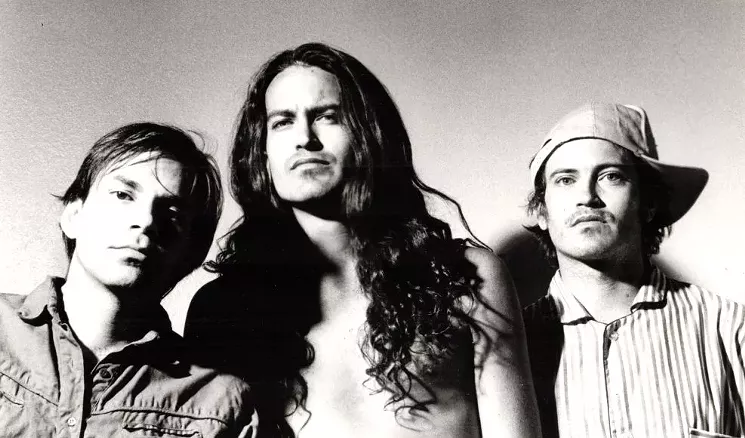
Derrick Bostrom (left), Curt Kirkwood (center), and Cris Kirkwood (right) of Meat Puppets.
High Road Touring
Meat Puppets
When Curt and Cris Kirkwood shared a stage with Nirvana during the MTV Unplugged in New York special in 1993, they exposed Meat Puppets to an audience of millions. By then, the Phoenix band (which originally featured drummer Derrick Bostrom) already had gained a substantial following, though not as big as after the release of 1994’s Too High to Die, and its primary single, “Backwater,” was released. Meat Puppets were more alt-rock/grunge at that point, which wasn’t their definitive sound. During the band's formation in 1980, they did more of a punk thing. Then came their cowpunk days, which evolved into a weirdish art-rock hybrid playing whatever else that’s suited their fancy.“One of the great things about the Meat Puppets is that they didn't sound like anything else,” says local musician Michael Pistrui. “They were their own sound.” While they toiled in obscurity for years, the band had many famous followers, including Henry Rollins, who helped Meat Puppets sign with SST Records in 1983. Nirvana also covered “Lake of Fire” for the aforementioned MTV Unplugged session, which multiplied the Puppets’ popularity exponentially. “They certainly had a big influence on a lot of folks, just with attitude and music and certainly great ties to the desert and a long history of playing here,” Dixon says.
Sun City Girls
In many respects, the Sun City Girls were cut from the same cloth as Meat Puppets. Both bands involved a trio of musicians that included a pair of brothers (in this case, Richard and Alan Bishop) who sported a chimerical sound in an artier vein who went from local obscurity to widespread critical acclaim. “They weren't a popular band at first, but were known in that specific art-punk scene," Pawlicki says.The similarities end there, as Sun City Girls' rock was more experimental and avant-garde. “Richard was such an advanced guitar player,” Pawlicki says. “He was a guy who was playing jazz and entirely different things than punk rock when he was in that scene. They're so genuinely unique that they're an influence on bands here, but they're an influence on bands around the world, literally, in their case. Whenever Sonic Youth came to town, the first thing they did was ask about the Sun City Girls.”
Jessi Colter
Best known for her longtime personal and professional relationship with singing partner, collaborator, and husband, the late Waylon Jennings, Mesa's Jessi Colter has her own share of fame. She penned and performed the chart-topping 1975 crossover hit singles "I'm Not Lisa" and “What's Happened to Blue Eyes.” Renowned vocalists like Marianne Faithfull and the late Chet Atkins and Rosemary Clooney sang her tunes. And Colter is also one of the few female members of country music's true outlaws, and an influence to current-day country stars Deana Carter and Faith Hill. “I think as many people knew Jessi through Waylon, because they were a team for a long, long time," Dixon says. "She's always been a great songwriter and singer in her own right."Markus Schulz
Long before he toured the globe, topped festival lineups, earned millions of dollars, and ranked as one of the biggest dance music artists globally, Markus Schulz was one of many DJs working the Valley’s nightclub circuit. In the '90s, the German mixmaster (who moved the Valley as a teenager) held it down at a weekly gig at bygone Scottsdale spot The Works, performed at local raves, and produced the weekly dance music radio show The Edge Factor. Schulz told New Times in 2016 how cutting his teeth in Arizona helped influence his later success. “I really think fondly back at the days at The Works, because I would try different things and see how it felt,” he says, “Whereas in a lot of places I wouldn't have been able to do that because you're judged right away.”Dierks Bentley
Country music's biggest blockbusters of recent memory are typically focused on any combination of the following: getting tipsy, gals in tight jeans, pickups, or getting tipsy with ladies in tight jeans in a pickup. Homegrown star Dierks Bentley is no exception, as he’s guilty of mining these tropes in chart-toppers like "Sideways," "5-1-5-0," and "Am I the Only One.” Not every song in his discography rocks a party-hardy vibe, as some of the Phoenix native's songs offer a more personal and sometimes reflective nature ("Say You Do," "Home," "Draw Me a Map," or "Up on the Ridge") rather than just celebratory anthems. And his success hasn't suffered in the slightest.JFA
Skate punk exploded in 1981, and it was JFA (a.k.a. Jodie Foster's Army) that dropped the bomb. The band's four-song EP, Blatant Localism, was released by Tony Victor's Placebo Records and sparked a revolution in the Valley with skating, thanks to the band's hard, fast, and aggressive brand of punk that perfectly suited the pursuit. “JFA provided lifestyle music to a group of young kids that really, up until that point, didn't have anything. And it just happened to come out of the desert,” Dixon says. “Placebo marketed it very well and they toured on a school bus all over the country, cranked out skateboards and T-shirts, and marketed themselves into influence to a whole new audience.”Local musician Michael Pistrui remembers being inspired by the band. “For me personally, JFA was one of the most influential, because I liked to skateboard, and the music, the lyrics, and the sound really hit home with not only myself but most of my high school friends,” he says. “The first time I saw them, it made me want to be in a band. Absolutely.”
Wayne Newton
When Wayne Newton hosted a concert feting Arizona's centennial in 2012, it seemed fitting, considering the world's most famous lounge lizard paid his dues in Phoenix. And though he might call himself “Mr. Las Vegas,” Newton spent his adolescence as “Mr. Valley of the Sun,” attending North High School and developing as a performer. “You could definitely say that he learned show business here,” Dixon says. “He spent a lot of time on a hay wagon with his brother Jerry opening up A.J. Bayless stores.” And he starred on the now-legendary KPHO variety program The Lew King Ranger Show, which was seen by a Las Vegas talent agent passing through town in 1958, and resulted in Newton getting his big break.Nate Ruess
As the story goes, local-boy-made-good Nate Ruess had only 10 minutes to convince high-profile producer Jeff Bhasker whether or not to work with fun. Out of desperation, the Glendale native belted out the chorus to a little song by the name of “We Are Young.” (Perhaps you've heard of it?) The rest is Grammy-winning, chart-topping, and career-making history.Thing is, Ruess' music has been influencing people before that, as his previous project, the critically acclaimed indie-rock act The Format (which he formed with Sam Means in 2001) fueled artists like Panic! at the Disco's Brendon Urie and caused an A&R rep from Elektra to offer the band a record contract after their first-ever gig at the now-defunct Nita's Hideaway in 2002. Perhaps the power of Ruess' golden voice makes one want to fork things over.
Jimmy Eat World
Interestingly enough, one of the bands that propelled Ruess into a music career was Jimmy Eat World, the Mesa band that changed the face of emo. Two years before their biggest hit, the pop-laced 2001 track “The Middle,” they released Clarity, the 13-song album that showcased Jimmy Eat World's musicianship, earnestness, sincerity, and ability to deftly blend power-pop and power ballads with emo without resorting to an overdose of melodrama.It was relatively ignored at the time but became widely exalted in the ensuing years, cited by a slew of prominent musicians (such as members of Manchester Orchestra, Fall Out Boy, and Yellowcard) as well as local bigwigs like promoter “Psyko” Steve Chilton) as a masterpiece. “They've influenced an entire sound,” Lanning says. “A lot of bands out there came after them trying to follow in that vein.”
Max Cavalera
If you’ve ever riffed on or ripped off guitarist Max Cavalera in developing your own metal offerings, he’s totally okay with it. As it turns out, the relationship is reciprocal. In a 2017 Loudwire Q&A, the Valley resident said he digs that his output over 36 years and multiple bands (including Soulfly and Nailbomb) has motivated musicians to create since he draws inspiration from their jams, too. “I’m not afraid to say to the world that I’m influenced by a lot of these new bands and a lot of them are influenced by what I did, so it's cool – everybody wins, everybody’s influenced by everybody.”Sam Moore
When Sam Moore relocated to Arizona years ago, the soul and R&B singer brought a huge legacy and list of accomplishments with him, not the least of which is his membership in the Rock and Roll Hall of Fame. The 84-year-old performer is, of course, best known for his lengthy pairing with Dave Prater in the duo Sam & Dave. Serving as the tenor counterpoint to Prater's baritone, the two struck up a partnership in 1961, and began lighting up the pop and R&B charts about four years later with such gems as “You Don't Know Like I Know,” “Hold On, I'm Comin,” “When Something is Wrong With My Baby,” “I Thank You,” and their trademark, “Soul Man.”It was a fruitful, if tempestuous, relationship between the musicians (as Moore and Prater fought frequently behind the scenes), but proved to be a dominant force in 1960s R&B that was an inspiration to countless rock stars and used as a template for Dan Aykroyd and John Belushi's Blues Brothers shtick.
Lee Hazlewood
Among his many claims to fame — including penning Nancy Sinatra's "These Boots Are Made for Walking," working with a pre-Byrds Gram Parsons, and sporting the swingingest mustache ever — the late Lee Hazlewood is an enormous figure in our state's music history. Dixon refers to the singer/songwriter/composer/arranger as “a linchpin” for his many contributions, including writing and producing such landmark Arizona songs and proto-rockabilly hits as Sanford Clark's “The Fool” in 1956 and Duane Eddy's “Rebel Rouser” in 1958.Both exemplified Hazlewood's signature reverb-heavy, twangy sound that was the hallmark of his early career. "The creation of one song begat the other, so with the success of ‘The Fool,’ Hazlewood got to write more songs, all the local musicians got to play on more sessions, and then two years later, with ‘Rebel Rouser,’ he crystallized that sound," Dixon says.
Duane Eddy
And the genesis of “Rebel Rouser” began in 1955 when the rock 'n' roll guitarist walked into Coolidge's KCKY where Hazlewood worked as a disc jockey. Eddy later served as a member of the station's house band during Hazlewood's show, the first of many collaborations between the two, the most important being “Rebel Rouser,” a song that Dixon says offered something truly unique for that era of rock.“It was something nobody else had ever done, and something that was heard around the world,” he says. “Duane Eddy influenced a whole generation or two of guitar players, and that twangy sound that was certainly unique and created here.” The song was as much a result of Eddy's skills on a six-string as the manner it was recorded, which took place in a local abandoned grain elevator that was an excellent echo chamber.
“Rebel Rouser” busted charts, leading to further Eddy hits like “Peter Gunn” and “Because They're Young.” In 1994, he was inducted into the Rock and Roll Hall of Fame. "Duane was as big as the Beatles in England in the early '60s ... he was right up there tied with them on the Melody Maker charts," Dixon says. "It's pretty neat to think about those songs being created right here in Phoenix."
Rob Halford
There are probably few modern-day metal frontmen who haven't taken cues from Judas Priest frontman and part-time Paradise Valley resident Rob Halford, whether it's his biker-meets-BDSM look, vocal fury, concert stunts, or stage bravado. As local concert promoter Danny Zelisko says, Halford just knows how to put on a show. “I think people look up to him for his ability to still bring an audience to their feet,” he says. "Everyone has borrowed from him, like Mötley Crüe or Van Halen ... all the L.A. metal bands and probably a lot of the European ones, too.”Waylon Jennings
The late Waylon Jennings may have been a proud son of Texas, but the outlaw country heavyweight made his bones here in Arizona. In the early ‘60s, Jennings moved to Coolidge due to his then-wife's illness, got hired on as a performer and DJ at KCKY, and began gigging at clubs in the Valley as a solo act and alongside his rockabilly band The Waylors. That included countless stints at long-defunct Scottsdale bar JD's, which Dixon says is where Jennings gained exposure and honed his performances. And he kept coming back, even after contracts with A&M Records and RCA. "He later went to Nashville but returned to record at JD's because even being an RCA recording artist, he made more money when he was playing there than being out on the road night after night." Jennings eventually settled in the East Valley in the '80s, but died in 2002 and is buried in Mesa.Maynard James Keenan
Having sold millions of albums, sold out venues worldwide, and shaped the genre of alternative metal, Tool/Puscifer/A Perfect Circle singer Maynard James Keenan can't be considering anything other than influential. It'd be hard to get him to admit that shit, though, as he demonstrated in a 2010 interview. After being asked if he ever reflects on his effect on other artists, the enigmatic singer eventually replied that he doesn't. "I guess the answer is no, I haven't really reflected on that because I haven't really," he stated. "That's nice to know that we've inspired people to do stuff."In the meantime, Keenan's occupied with doing his own stuff, either out in L.A. or up in Jerome. When in central Arizona, he could be found making wine at his Caduceus Cellars vineyard, hawking Puscifer’s ephemera at their nearby boutique, or recording at his private studio. Wherever Maynard's interests take him next, we're sure it will inspire someone else in some way, even if he couldn't care less.
Alice Cooper
When shock-rocker Alice Cooper first strapped on leather, slapped on makeup, and combined rip-roaring rock ‘n’ roll with fiendish stage theatrics in the ’70s, it was, to paraphrase Slash from Guns N’ Roses, the perfect marriage. And an unholy one at that. “When he first came out, people were afraid of him,” Zelisko says. “The key thing was, if your parents hated him, he felt it had a good chance of being successful. That was one of his mottos.”Cooper spawned hordes of offspring over the ensuing decades, from more immediate imitators like KISS, King Diamond, and Twisted Sister to admitted fans like Rob Zombie, Marilyn Manson, and Gwar. He also blasted out some fantastic rock to go along with all the shock, helping lay the groundwork for heavy metal. “It's been a combination of the show, theatrics, and really great rock music,” Zelisko says. “Alice has always been a big fan of really great rock from the beginning. He's led the way for a lot of people.”
Stevie Nicks
Legendary songstresses like Taylor Swift, Deborah Harry, Sheryl Crow, and Sarah McLachlan all owe a debt of thanks to Stevie Nicks, as the Fleetwood Mac singer and Phoenix native was an influential and groundbreaking figure in the rock-pop world because of her vocal abilities, stage presence, and performances.“She's a real point of pride for women singers everywhere: strong, articulate, intellectual, talented ... all wrapped into one package," says Zelisko. "Her voice, her vibe, her style onstage, I would say the word is 'mesmerizing.' She had a really, really great way of delivering her message, not just vocally, but she was captivating to watch. When you think of the great singers in rock, who is most revered? To me, she stands up there at the top of the list."
Chester Bennington
The late Chester Bennington had a long and storied history in Valley. Long before joining Linkin Park in 1999, the Phoenix native gigged endlessly local bars and venues with his original band, post-grunge Grey Daze, wowing crowds with his dynamic singing style and enigmatic stage presence. He brought these aspects to LP, helping the alternative metal act rocket to rock 'n' roll stardom in the early 2000s.
Their debut album, Hybrid Theory, sold 24 million copies and showcased Bennington’s unique vulnerability, introspective lyrics, and vocal artistry, all of which allowed Linkin Park to stand apart from the glut of nu-metal acts dominating music at the time. His influence reached beyond rock, inspiring artists such as Rihanna and Chance the Rapper.
Linda Ronstadt
When Linda Ronstadt revealed in 2013 she was unable to sing because of complications from Parkinson's disease, it was heartbreaking news. One of the most sumptuous voices in music, as much a treasure of Arizona as any of our natural wonders, had been silenced after 40-plus years of transforming words on a page into poetry divine. The crown jewel of Arizona's expansive Ronstadt family, Linda brought to life whatever she sang during her diverse career — be it early folk-rock with The Stone Poneys (including her star-making turn on "Different Drum"), her '70s country-rock period (personified by “Blue Bayou”), dalliances with post-punk and jazz in the '80s, or mariachi and other traditional Latin sounds.“I think Linda was always more of an interpreter and a song-stylist,” Zelisko says. "One of the best pure singers ever, and never was any of a big flashy thing onstage, just great looking and that great voice." Like Nicks, Ronstadt paved the way for women artists, he adds. "Before her, you really didn't have a lot of powerful female solo vocalists. Good girl groups and stuff like that, but after Linda, female singers developed power and strength in their popularity and they became a force to be reckoned with.”
Editor's note: This article was previously published in December 2014 and June 2016 and has been updated.





